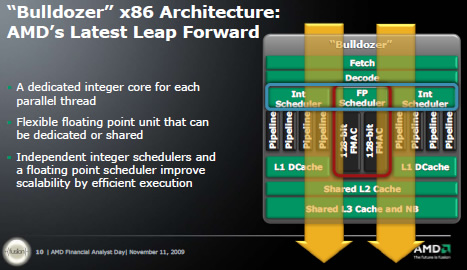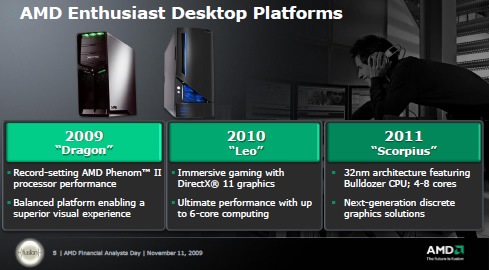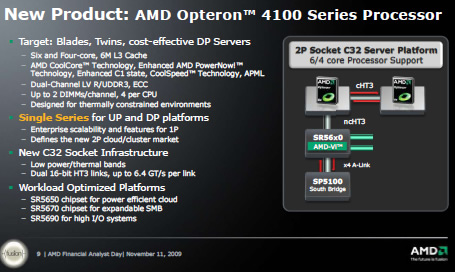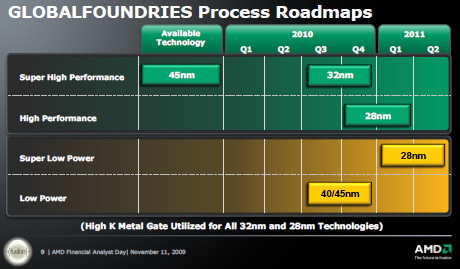
AMD Unveils New Platforms, Outlines 2010-2011 Chip Roadmap
AMD today announced new details on its platform roadmap at the 2009 Financial Analyst Day, where attendees got to see firsthand the roadmaps outlined for platforms and technology that span the most popular usage scenarios for users at work, at home and at play.
"In 2009, AMD transformed into a design innovation leader with a new business model tuned to deliver consistent financial performance," said Meyer. "In 2010, we plan to extend our clear graphics leadership and market momentum with new server and client platforms designed to deliver superior performance against key end-user workloads. And in 2011, we plan to usher in a new era of computing with our first AMD Fusion products, placing AMD on a clear path to industry leadership."
AMD's roadmap for 2010 is scheduled to be followed with the advent of "Fusion" and the first Accelerated Processing Unit (APU) codenamed "Llano," in 2011.
AMD also plans to bring to market the first ?"Bulldozer" and "Bobcat" core-based platforms, focusing on power, performance and size.
As highlighted in the platform and technology roadmaps presented today, here are the highlights of what's scheduled to come in 2010 and 2011 :
Next-Generation Technologies for Next-Generation Graphics
While AMD maintains momentum in rolling out several more DirectX 11 capable parts from its ATI Radeon HD 5000 series in 2H09 and 1H10 including graphics cards codenamed "Cedar," "Hemlock," and "Redwood," AMD will also introduce DirectX 11 capable members of the ATI Mobility Radeon HD 5000 series in 2010, bringing high graphics capabilities and HD video to AMD?s new notebook platforms.
"Bobcat" is AMD's low-power x86 processor core aimed at notebook processing in ultrathin and netbook form factors, and designed to be extremely small and single threaded.

"Bulldozer" is AMD's completely new, high performance architecture for the mainstream server, mainstream desktop and notebook PC markets that employs a new approach to multithreaded compute performance for achieving advanced efficiency and throughput. "Bulldozer" is designed to give AMD an exceptional CPU option for linking with GPUs in highly scalable, single-chip Accelerated Processing Unit (APU) configurations.


Notebook Platforms:
"Danube" is AMD's new platform for the mainstream notebook market and will feature the new "Champlain" CPU, the first quad-core processor offered by AMD specifically for the notebook market that includes 2M cache and DDR3 memory support.
"Sabine," is AMD's new mainstream notebook platform slated for 2011 and will be the first notebook platform to feature the quad-core "Llano" APU.
"Nile" is AMD's next generation platform for ultrathin notebooks and is scheduled for 1H10, with the dual-core "Geneva" CPU using DDR3 memory technology and is being designed to yield more than 7 hours of battery life under normal usage conditions.
"Brazos" is AMD's ultrathin notebook and netbook platform slated for 2011, and "Ontario" is the APU based on the "Bobcat" core.




Desktop Platforms:
"Leo" is AMD's next generation enthusiast-class desktop PC platform. Scheduled for 1H10, "Leo" will feature the first six-core desktop CPU, codenamed "Thuban," for greater multi-tasking, as well as DirectX 11 capabilities for a visually enhanced gaming experience.
"Dorado" is AMD's next-generation mainstream desktop platform with AMD Athlon II processors, DirectX 11 discrete graphics options, and stream application acceleration.
"Lynx," and "Scorpius" are AMD?s desktop platforms for 2011. "Lynx" is the first desktop platform powered by the quad-core "Llano" APU. "Scorpius" is an enthusiast-class desktop platform featuring the "Zambezi" CPU, the first 8-core solution for enthusiast desktop users based on the "Bulldozer" core.



Server Platforms:
"Maranello" is AMD's next generation server platform and remains on track for introduction in 1H10. "Maranello" is a DDR3-based server platform which is expected to offer a new socket infrastructure, Socket G34, to support upcoming 8 or 12-core "Magny-Cours" processors.
"San Marino" is AMD's new server platform suited for large, dense deployments that require power efficiency and flexibility that is ideal for small/medium businesses, as well as web, cloud and infrastructure applications.

AMD officially announced its 4000 series Opteron processors designed to appeal to a new market segment for power-efficient and low-cost servers. The company also confirmed it is bringing forward the launch of its 6000 series to Q1 of 2010, earlier than originally planned.
Due to ship in Q2 2010, the Opteron 4000 series will be split into chip lines San Marino and Adelaide, targeting power efficiency and low cost, respectively. Both will fit into a new processor socket, the C32, and are expected to have four to six cores with a maximum total power consumption of 35W.
Also due to launch in Q2 2010, the Opteron 6000 series is the flip side of the coin from the 4000 series. Codenamed Magny-Cours, these chips will be "the first eight and 12 core x86 processors on the market", according to AMD, and will fit server systems with two or four sockets, enabling them to effectively replace the existing Opteron 1000, 2000 and 8000 chips.
The Opteron 6000 series will be based on a second different socket, the G34, but both the 4000 and 6000 chips will use the same chipsets and will be Bios, driver, and software compatible.
Both platforms also move to supporting only DDR3 memory, with the 4000 series having two memory channels while the 6000 series can have up to four.
Looking further ahead to 2011, the 4000 series will move to a next-generation core codenamed Valencia that will have six to eight cores, but will be socket and thermal compatible with the first generation.
During the same timeframe, the 6000 series will move to the Interlagos core with 12 to 16 cores. Both will be based on the new Bulldozer architecture.


AMD's roadmap for 2010 is scheduled to be followed with the advent of "Fusion" and the first Accelerated Processing Unit (APU) codenamed "Llano," in 2011.
AMD also plans to bring to market the first ?"Bulldozer" and "Bobcat" core-based platforms, focusing on power, performance and size.
As highlighted in the platform and technology roadmaps presented today, here are the highlights of what's scheduled to come in 2010 and 2011 :
Next-Generation Technologies for Next-Generation Graphics
While AMD maintains momentum in rolling out several more DirectX 11 capable parts from its ATI Radeon HD 5000 series in 2H09 and 1H10 including graphics cards codenamed "Cedar," "Hemlock," and "Redwood," AMD will also introduce DirectX 11 capable members of the ATI Mobility Radeon HD 5000 series in 2010, bringing high graphics capabilities and HD video to AMD?s new notebook platforms.
"Bobcat" is AMD's low-power x86 processor core aimed at notebook processing in ultrathin and netbook form factors, and designed to be extremely small and single threaded.

"Bulldozer" is AMD's completely new, high performance architecture for the mainstream server, mainstream desktop and notebook PC markets that employs a new approach to multithreaded compute performance for achieving advanced efficiency and throughput. "Bulldozer" is designed to give AMD an exceptional CPU option for linking with GPUs in highly scalable, single-chip Accelerated Processing Unit (APU) configurations.


Notebook Platforms:
"Danube" is AMD's new platform for the mainstream notebook market and will feature the new "Champlain" CPU, the first quad-core processor offered by AMD specifically for the notebook market that includes 2M cache and DDR3 memory support.
"Sabine," is AMD's new mainstream notebook platform slated for 2011 and will be the first notebook platform to feature the quad-core "Llano" APU.
"Nile" is AMD's next generation platform for ultrathin notebooks and is scheduled for 1H10, with the dual-core "Geneva" CPU using DDR3 memory technology and is being designed to yield more than 7 hours of battery life under normal usage conditions.
"Brazos" is AMD's ultrathin notebook and netbook platform slated for 2011, and "Ontario" is the APU based on the "Bobcat" core.




Desktop Platforms:
"Leo" is AMD's next generation enthusiast-class desktop PC platform. Scheduled for 1H10, "Leo" will feature the first six-core desktop CPU, codenamed "Thuban," for greater multi-tasking, as well as DirectX 11 capabilities for a visually enhanced gaming experience.
"Dorado" is AMD's next-generation mainstream desktop platform with AMD Athlon II processors, DirectX 11 discrete graphics options, and stream application acceleration.
"Lynx," and "Scorpius" are AMD?s desktop platforms for 2011. "Lynx" is the first desktop platform powered by the quad-core "Llano" APU. "Scorpius" is an enthusiast-class desktop platform featuring the "Zambezi" CPU, the first 8-core solution for enthusiast desktop users based on the "Bulldozer" core.



Server Platforms:
"Maranello" is AMD's next generation server platform and remains on track for introduction in 1H10. "Maranello" is a DDR3-based server platform which is expected to offer a new socket infrastructure, Socket G34, to support upcoming 8 or 12-core "Magny-Cours" processors.
"San Marino" is AMD's new server platform suited for large, dense deployments that require power efficiency and flexibility that is ideal for small/medium businesses, as well as web, cloud and infrastructure applications.

AMD officially announced its 4000 series Opteron processors designed to appeal to a new market segment for power-efficient and low-cost servers. The company also confirmed it is bringing forward the launch of its 6000 series to Q1 of 2010, earlier than originally planned.
Due to ship in Q2 2010, the Opteron 4000 series will be split into chip lines San Marino and Adelaide, targeting power efficiency and low cost, respectively. Both will fit into a new processor socket, the C32, and are expected to have four to six cores with a maximum total power consumption of 35W.
Also due to launch in Q2 2010, the Opteron 6000 series is the flip side of the coin from the 4000 series. Codenamed Magny-Cours, these chips will be "the first eight and 12 core x86 processors on the market", according to AMD, and will fit server systems with two or four sockets, enabling them to effectively replace the existing Opteron 1000, 2000 and 8000 chips.
The Opteron 6000 series will be based on a second different socket, the G34, but both the 4000 and 6000 chips will use the same chipsets and will be Bios, driver, and software compatible.
Both platforms also move to supporting only DDR3 memory, with the 4000 series having two memory channels while the 6000 series can have up to four.
Looking further ahead to 2011, the 4000 series will move to a next-generation core codenamed Valencia that will have six to eight cores, but will be socket and thermal compatible with the first generation.
During the same timeframe, the 6000 series will move to the Interlagos core with 12 to 16 cores. Both will be based on the new Bulldozer architecture.























